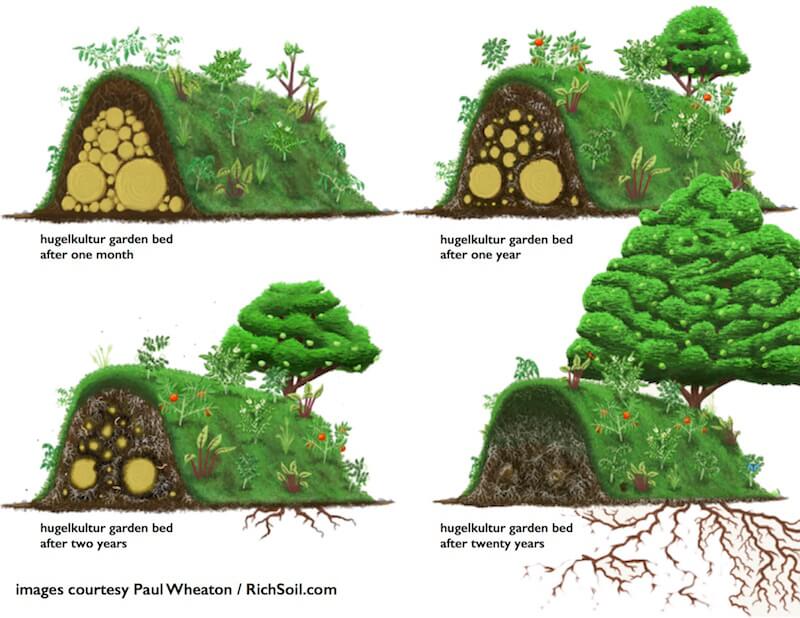Hoo-guh-what?! Hugelkultur, pronounced, “Hoo-Gul-Culture,” means hill culture or hill mound in German. Hugelkultur raised beds are no-dig raised beds that hold moisture, build fertility and maximize surface volume so that you get double the yield when harvest time comes.
So, instead of putting all of your raked branches, leaves, and grass clippings in bags by the curbside, build a hugelkultur raised bed!
What Is Hugelkultur?
According to permaculture expert Paul Wheaton:
“Hugelkultur is nothing more than making raised garden beds filled with rotten wood. This makes for raised garden beds loaded with organic material, nutrients, air pockets for the roots of what you plant, etc. As the years pass, the deep soil of your raised garden bed becomes incredibly rich and loaded with soil life.”
Hugelkultur raised beds are similar to lasagna gardening and sheet mulching – methods that require no digging and no tilling, and which result in rich, fluffy soil with very little work from the gardener. Hugelkultur raised beds, like lasagna gardening and sheet mulching, are particularly effective in areas with poor soil quality, because they are built above the soil surface. The layers of these methods help hold nutrients in the soil much longer than if compost or fertilizers were applied directly to the soil surface.
While Hugelkultur is similar to gardening methods like lasagna gardening and sheet mulching, it still differs in a few key ways (1):
1. Woody Base
Hugelkultur raised beds depend on a foundation of wood. This includes things like tree trimmings, logs, clean scrap lumber or even trees that have fallen over. The slow break down of this woody base keeps soil fertility and moisture retention strong over years or even decades.
2. Size
You can make your hugelkultur big or small, but some of them have been built as high as six feet tall! In some cases, hugelkultur raised beds are build over entire fallen trees. While the sky’s the limit for building a hugelkultur, most people only have room for hugel beds that are one to two feet tall – and that’s totally fine!
3. Steeply Sloped Sides
Hugelkultur beds also come with steeply sloped sides. Keeping the sides sloped at 45 degrees is thought to reduce soil compaction over time, as well as increase soil oxygenation.
4. Moisture Retention
The woody base of the hugel bed slowly breaks down over time – the cellulose and lignin-eating fungi slowly consume the woody base material, transforming the logs, branches and wood chips into sponge-filled masses with tiny air pockets. These tiny air pockets create excellent moisture-retainers, which encourage strong plant root growth. Even in dry climates, the smallest of hugels can go weeks without supplemental irrigation. Large hugels, on the other hand, can support lush growth through an entire summer without additional water.
The Benefits of Hugelkultur Raised Beds
There are so many benefits of building a hugelkultur raised bed.
For starters, they work very well in dry areas, even deserts, due to their outstanding ability to hold water. They require little, if any, irrigation, making them an incredibly sustainable addition to any garden. They also don’t need any fertilizer, because they are planted in almost pure compost, which is very nutrient-dense.
The beds create different microclimates suitable for the varied needs of different plants. For example, the side facing the sun can be used for plants that require direct sunlight, where as the shadier side can be used for delicate leafy greens and kale, for instance.
The wood used underneath the hugel bed slowly decomposes over time, so the soil warms up faster in the spring (compared to conventional flat-bed gardening). This helps the growth and germination of seeds, particularly in the spring, and allows for an earlier start of growth.
The soil is also loose and well aerated, meaning that it doesn’t freeze as fast in cooler areas.
The nutrients locked up in the wood get released slowly over a period of several years. Even vegetables with a high nutrient demand can be grown without the use of additional fertilizer.
Last but not least, the method of hilling, or sloping the raised bed, helps to increase surface area, allowing for more grow space. This is particularly useful in small gardens with limited space.
How To Make A Hugelkultur Raised Bed
The rising popularity of hugelkultur has to do with its association with permaculture. Permaculture is an increasingly popular gardening philosophy that seeks to mimic and incorporate natural relationships and systems into the garden.
If you are wanting to incorporate a hugel bed into your garden, you’ll want to think about the system as a whole. The beds you build are long-term, and will get better as the years pass on.
There are a few key things you will want to consider before building your hugel bed:
1. Sun
Some hugel beds are built running east-west so that the mounded bed has a hot and sunny south side and a cooler shaded north side. If you want to plant vegetables and fruit that require plenty of direct light, run the bed north-south so that your crops receive more even light exposure. If you’re planting a combination of direct light and low light vegetables and greens, then running east-west is your best bet.
2. Water
Look at the water flow in your garden, and pin-point the areas that are low-lying and moist, and the areas that are easily drained. If you position your hugel strategically, it will soak up, or re-direct excess water. If there is too much water, however, it can undermine the bed’s structure.
3. Wind
If you plan on making a really tall hugel bed, you will be modifying the air-flow in your yard. You’ll want to think about where the dominant winds come from in your climate, and what areas might benefit from a wind-block in your garden. You’ll also want to consider what you plan on growing in your hugel. Crops that are planted on the top will have little shelter, and will have to cope with lots of wind if planted in an exposed, windy location.
4. Shape
The shape of your hugel doesn’t have to be perfect. A lot of them tend to take freeform shapes like gentle arcs, open bowls, or whatever shape would be best suited to the climate (taking light, water and wind into consideration). After all, some hugel beds have been built over fallen trees!
5. Location
If you have termite issues, avoid building your hugel too close to your home.
6. Type of Wood
Depending on the size of your hugel, you will need varying amounts of wood. If you know you want to add hugelkultur into your garden, start saving logs, cut branches, tree trimmings and other garden wood, even if you’re not sure where they’ll end up.
Some woods contain natural chemical agents that make them very slow to break down, so in that case, you’ll want to avoid:
– Cedar
– Black locust
– Black cherry
– Black walnut
Any wood that is chemically treated (not naturally), like pallets, painted/stained wood, or pressure-treated wood should not be used. Wood chips can be used, but it will not offer the same longevity of fertility that a classic hugel full of larger logs and timbers would.
Building Your Hugelkultur Raised Bed
Below are the steps to building your hugelkultur raised bed.
STEP 1. Lay down your scrap wood (freshly cut, well-rotted, or anything in between), with larger trunks and stumps on the base, and smaller twigs and branches up top. Water well.
Tip: The bigger the better. The larger your mound is, the more resilient it will be in regards to irrigation and fertilizer. The recommended size is about two metres by one metre with a height of about two metres. While you don’t have to make your hugel this large, it is recommended, as it will allow for shrinkage in the first month as it settles down.
STEP 2. Fill the gaps of the wood with compost, manure, leaves, kitchen-waste, etc. This nitrogen-rich layer will help balance high levels of carbon in the wood. Covering your hugel with grass sod face down is also highly recommended (always make sure the grass sod is face down, as the grass might grow through again if faced up).
STEP 3. Finish with a layer of topsoil about 5 cm deep and then a layer of mulch (like straw).
STEP 4. You can plant in the hugelkultur raised bed right away, but if you allow it to cure (like over winter), it will give it time to settle and soak in rainwater. However, if you don’t want to wait and want to plant in the hugel right away, you are doing no harm in doing so.
Note: You can start off with smaller/lower beds and add to them over a few years to create a taller bed. However, the smaller beds won’t be as resilient and will require some watering (although far less than a ‘normal’ raised bed containing just soil and compost).





The article says ‘ The recommended size is about two metres by one metre with a height of about two metres.’
2m tall is massive, is this a mistake? Thanks.
Hi Jill – nope, that’s correct! You can make them very big. Of course, you can make a smaller one if you please.
Also if it’s just left as bare soil covered in straw won’t it fill with weeds? Does it have to be completely planted to avoid excessive weeds?
Straw prevents weeds from growing if you pile it high enough 🙂
CAN WE GET A PRINTOUT OF THIS ? OR IS THERE A BOOL
You can print the page at the top of the article there is a print option.
We have termites here. I wouldn’t bury a tree trunk for that reason. My be OK in a colder region.
If straw is the top layer how do you prevent it from blowing away in the wind?
Just water it down every day until it starts to settle into itself. I use straw in my garden all the time and it seems to work out well if I water it down.
We have terrible soil, mainly solid hard as a rock red clay. Does this method work for flower beds too?
This might be a bit extensive for flower beds, but a mini version might work?
Can you use mowed grass to fill in a hugelkulture?
Yes!